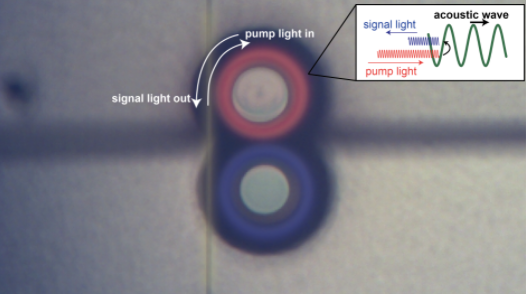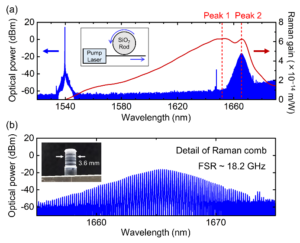Brillouin laser using a coupled-cavity system
Research
Brillouin laser using a coupled-cavity system
Toward Miniaturization of Microwave Photonics
The frequency of light is 193 THz at 1550 nm, which is commonly used in the communication wavelength band, whereas the frequency of microwaves is generally in the GHz band, which is significantly different. In this research, we have experimentally demonstrated that it is possible to realize an on-chip system for converting light to microwave frequencies.
Then why is it necessary to generate microwaves via light? Microwaves cannot be transmitted over long distances due to the large transmission loss caused by coaxial cables if they are transmitted as they are. In addition, the higher the frequency of the microwaves generated by a quartz crystal oscillator or other means, the higher the noise level will be.
In recent years, many studies have been conducted to solve these problems by optically generating microwaves. The method of generating microwaves from light uses a mechanism in which two light waves of different frequencies and phase alignment are detected by a photodetector, and microwaves corresponding to the difference in frequency are obtained. This method enables transmission over long distances using optical fibers.
To achieve this, it is important to provide two "phase aligned" lights. This leads to low noise. One way to achieve this is to use Brillouin lasers. Brillouin lasers are systems that enhance induced Brillouin scattering. In order to efficiently induce induced Brillouin scattering, it is necessary to confine a high intensity of light to a small space, and an optical resonator is used to satisfy this requirement. Although Brillouin lasers with a single resonator have been demonstrated in previous research, it is necessary to precisely control the size of the resonator, and the size of the resonator is relatively large (mm size). In this study, we have removed this difficulty by using two optical resonators and succeeded in creating a Brillouin laser with a smaller system (100 μm).

Figure 1: Brillouin laser with coupled resonator

Figure 2: Experimental results
- Categories
- 研究トピックス



